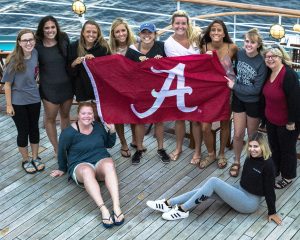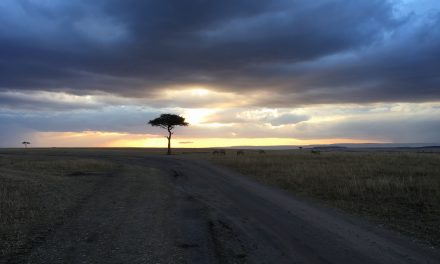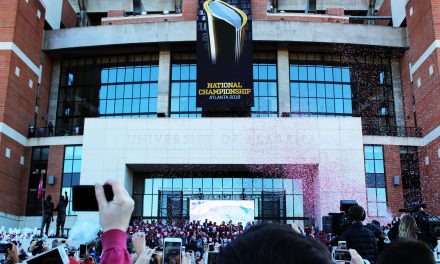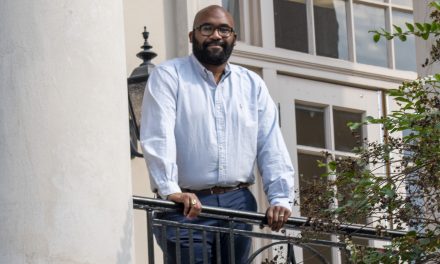STORY BY
HEATHER GRIFFITH
DESIGN BY
TERRY MANTOOTH
Every semester, nearly 600 students flood a dock, a suitcase in each hand, as they wait to board the MV World Odyssey, a 574-foot ship to embark on the journey of a lifetime: Semester at Sea.
Semester at Sea (SAS) is a four-month journey around the world that brings together students, faculty and life-long learners from over 250 universities and 30 countries. Over the course of 102 to 107 days, voyagers visit between 10 and 15 countries, taking classes for credit during their time on the ship.
“Their mission is to push you to find areas of yourself that you didn’t even know were there,” said Courtney Cassin, a fall 2016 Semester at Sea alumna and UA senior.
Students who wish to participate in SAS must first apply, during which process a student writes an essay describing how participating in SAS will enhance the student’s global perspective. Once a student is accepted, the seemingly endless preparations begins.
“I had to renew my passport, apply for visas, get vaccinations, apply for scholarships, find a roommate, get clearance from UA, register for classes, sign up for field programs, figure out a phone plan, exchange currency, research the culturally appropriate ways to dress in each country, and God knows what else,” said Megan Perkins, a public relations major, Honors college student and voyager on the Spring 2017 journey. “But it was beyond worth it, and I would take on three times as much work if it meant I could do SAS again.”
Students who participate in SAS not only take on a tremendous time commitment, but also take on a massive financial commitment. The cost of SAS can range from $25,074 to $31,074. This number includes tuition, housing and meals aboard the ship. Although a daunting number to most people, many students receive financial aid from home institutions and/or Semester at Sea to help make the cost more manageable, and to ensure the experience is open to students of all backgrounds.

Credit: Courtney Cassin
Though costly, Semester at Sea is about more than taking classes aboard a ship; it’s about learning, traveling and experiencing the world alongside people you’ve only known a few weeks, but who will become lifelong friends.
“You are going to get on the ship and you are going to meet incredible people. Every person has a story and something to offer,” Cassin said.
One of the many things that makes SAS stand out from other study abroad programs is that students have limited to no internet access throughout their time on the ship. While this may seem intimidating for some young students, it is a vital part of the SAS experience, one that helps to enrich every student’s time on the ship.
“The beauty of being in the middle of the ocean is being disconnected,” Cassin said. “You build friendships faster, you laugh more and your conversations are richer.”
When students aren’t building friendships on the boat, they’re taking advantage of their time in port. Students have four to six days in each country they visit, and often willingly sacrifice sleep in order to get the most out of their limited time in each port.
Students have a seemingly endless realm of opportunity during their four months at sea, and the adventures they partake in are entirely their own to choose. The only in-port requirement is a one-day field class for each class they take on the ship. Besides that, students have complete freedom when in port, as long as they don’t leave the country.
For some students, this freedom means great white shark cage diving in South Africa, hot air ballooning in Myanmar, or sleeping on the Great Wall of China. However, for many students, it’s also an opportunity to give back to the world through community service projects.
“I got to teach at a school in Ghana, something I would not have been able to do on my own,” said Amber Cargill, a fall 2017 alumna and UA sophomore on the pre-med track with a focus on psychology and biology.
These experiences help drive one of Semester at Sea’s main missions: enhancing every student’s global perspective. SAS encourages students to engage with locals as often as possible, as this can be one of the most effective and organic ways to experience a new country. Four months may not seem like a long time, but for the students participating in Semester at Sea, it is enough time to change their entire outlook on life.

Credit: Dr. Mary Meares
While Semester at Sea’s main focus is on its students, the experience also affects faculty like Dr. Mary Meares, a global studies professor on the fall 2016 voyage. The walls of Meares’ University of Alabama office are plastered with stunning photos from her travels which brought her to more than 50 countries, including temporarily living in Japan. Yet, Meares still claims
“It is such a wonderful program because people are having amazing experiences and processing them on the ship and learning about the places that they are going to next,” Meares said.
While learning about and traveling to these countries can be a somewhat overwhelming experience, and often results in a lack of sleep and possible bouts of sea-sickness, most students have nothing but positive things to say about their Semester at Sea voyage.
“The worst experience is coming back,” Cargill said. “There’s a reverse culture shock, getting used to your life back here. I’m so happy I got to do it, but I can’t help but sometimes really miss it. You know your life is never going to be quite as crazy as it was during those four months.”
For the voyagers on this journey of a lifetime, the experience never truly ends. They will forever carry their memories and experiences, good and bad, and the things they learned will forever affect the way they live their lives, both within and outside the United States.






